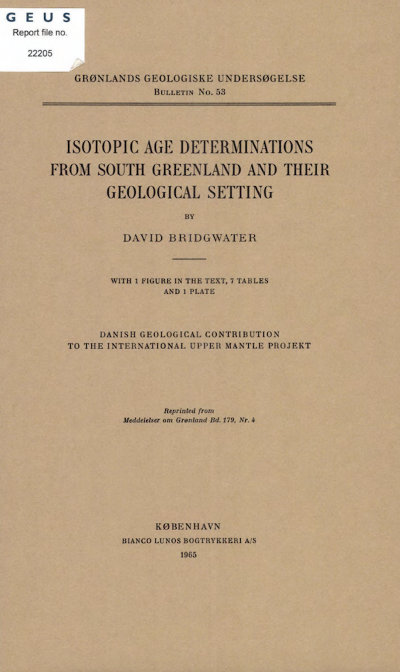Isotopic age determinations from South Greenland and their geological setting
DOI:
https://doi.org/10.34194/bullggu.v53.6587Abstract
A brief geological review of the area between Sermiligârssuk and Kap Farvel is given using the following five main divisions of the Precambrian of South Greenland: 1) pre-Ketilidian (? 2000-2700 m. y.) 2) Ketilidian (? 1700-2000 m. y.) 3) post-Ketilidian = Kuanitic (? 1650-1700 m. y.) 4) Sanerutian (? 1500-1650 m. y.) 5) Gardar (1020-?1500 m.y.). In the area described these divisions are characterized by: 1) gneisses, 2) geosynclinal sedimentation and lava extrusion, metamorphism and plutonism, 3) basic and intermediate dyking, 4) renewed plutonism, and emplacement of synplutonic basic, intermediate and granitic rocks, 5) post-orogenic sedimentation, lava extrusion and a predominantly alkali suite of intrusive rocks. Isotopic age determinations are available from the two youngest of the above divisions in South Greenland; dates for the three older divisions are suggested by comparison of the development of South Greenland with other fold belts together with sparse data from elsewhere in Greenland. It is suggested that the pre-Ketilidian gneisses represent the remnant of an old fold belt formed approximately 2400-2700 m. y. ago which has been reactivated during the Ketilidian and Sanerutian plutonic episodes in South Greenland. It is further suggested that the Ketilidian, post-Ketilidian and Sanerutian episodes are phases in the evolution of one fold belt which started at approximately 2000 m. y. ago and represents the beginning of the Svecofennid chelogenic cycle in South Greenland. The Gardar magmatism is regarded as a typical post-orogenic alkali suite and it is thought that the Gardar activity at about 1200 m. y. may represent compensatory tensional conditions on the margins of the developing Grenville fold belt which probably passed south of Greenland. Eight K/Ar age determinations (Geochron Laboratories) give the following results: Sanerutian hypersthene gabbro, 1645 m. y. (biotite) and 1700 m. y. (augite); Sanerutian granite, 1620 m. y. (biotite) ; early Gardar dolerite, 1435 m. y. (augite); Gardar syenite, 1128 m. y. (biotite) and 1355 m. y. (augite); inclusion of anorthosite fragment in a Gardar dyke, 1025 m. y. (biotite) and 1075 m. y. (augite). Four Rb/Sr age determinations (Moorbath) give the following results: Ketilidian pegmatite affected by Sanerutian metamorphism, 1630 m. y; Sanerutian granite, 1615 m. y.; Sanerutian granite probably affected by Gardar event, 1220 m. y.; Gardar biotite granite, 1150 m. y. Results from other areas in Greenland are discussed and it is suggested that a large part of the south-west coastal strip is pre-Ketilidian in age and that the Nagssugtoqidian fold belt was formed at approximately the same time as the Ketilidian-Sanerutian fold belt in South Greenland, that is at the beginning of the Svecofennid chelogenic cycle. It is suggested that the main episodes described from South Greenland correspond to events in the Canadian shield as follows: pre-Ketilidian plutonism = Kenoran; Ketilidian-Sanerutian and Nagssugtoqidian = Hudsonian; Gardar = post-Hudsonian, pre-Grenville igneous activity. Tectono-igneous cycles are used in conjunction with basic dykes and age determinations as a method of dividing the Precambrian.
Downloads
Published
Issue
Section
License
This article is distributed under a CC-BY 4.0 licence, permitting free redistribution and reproduction for any purpose, even commercial, provided proper citation of the original work. Author(s) retain copyright over the article contents.


